Apple's 11-inch Upgraded MacBook Air: Do 1.6GHz and 4GB Make a Difference?
by Anand Lal Shimpi on November 6, 2010 2:35 AM EST- Posted in
- Mac
- Apple
- MacBook Air
- Laptops
Performance
Adobe Photoshop CS4 Performance
The Retouch Artists Speed Test we use for our CPU testing under Windows also works under OS X. We're running the exact same benchmark here, basically performing a bunch of image manipulations and filters and timing the entire process.
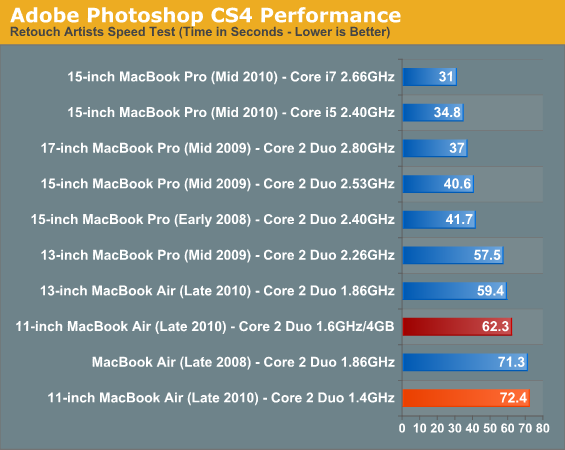
Photoshop benefits tremendously from the upgrade to 4GB. The application takes advantage of both the faster CPU and larger memory size. The combination of the two bring the 11-inch system within 5% of the 1.86GHz, 2GB 13-inch MacBook Air. A 16% increase in performance over the base 11-inch configuration. Definitely, a tangible improvement.
Aperture 2 RAW Import
For my Aperture test I simply timed how long it took to import 203 12MP RAW images into the library.
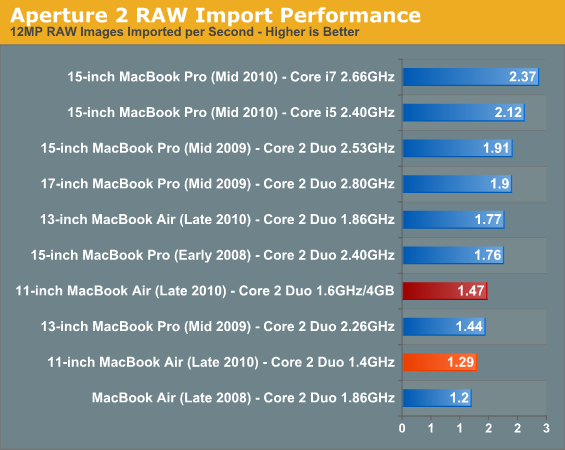
Our Aperture import test is equally impressive. We measured a 14% increase in performance over the base configuration. Although in this case, the 13-inch MBA was still 20% faster than the upgraded 11. Once more, the system didn’t only benchmark quicker, but it felt faster in use.
Cinebench R10
I’m a fan of the Cinebench test because it lets me show off both single and multithreaded performance in the same workload.
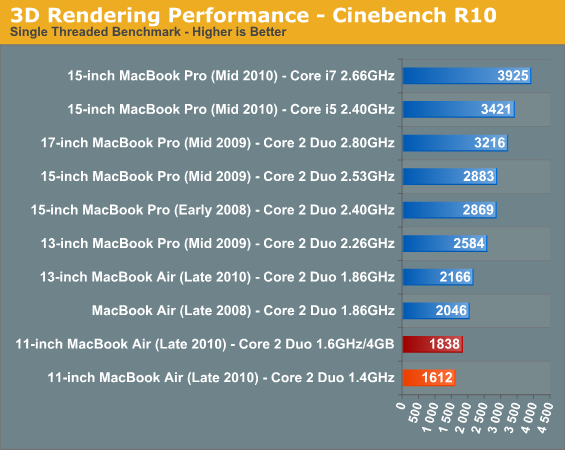
Cinebench is perfect for isolating the potential for CPU improvement. These tests are entirely CPU bound and as a result we see a ~14% improvement from the upgraded 11 vs. the base model. This is important to confirm because it means that despite the higher clock speed, Apple isn’t aggressively throttling the Core 2 in the upgraded system. If you pay for the extra 200MHz, Apple gives it to you - no strings attached.
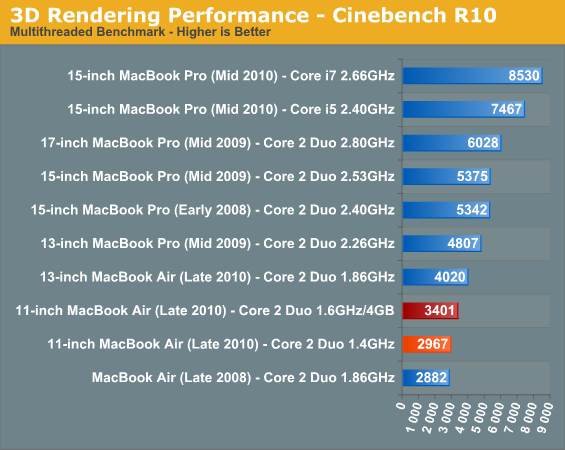

The only indication of something funny going on was our run through Cinebench 11.5. The multi-threaded score was only 13.5% higher than the 1.4GHz model, indicating that the chip most likely pulled back below 1.6GHz (likely only down to 1.5GHz).
Quicktime H.264 & Handbrake Video Encoding
Our Quicktime benchmark is more consumer focused. Here I'm taking an XviD and converting it to an iPhone-supported H.264 format.
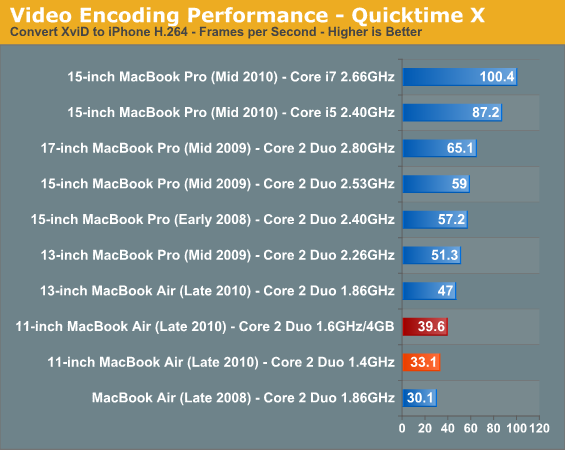
Our Quicktime transcode test proved to stress both the CPU and memory upgrades, resulting in a total performance increase of 19.4%. These are significant gains, definitely noticeable in real world use. Despite the huge improvement however, the 13-inch MacBook Air is still 18.8% faster - partly due to clock speed, and partly due to its larger L2 cache.
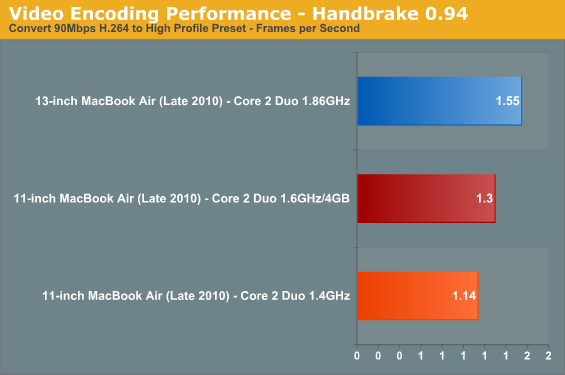
On average the upgraded system was 15% faster than the base 11-inch MacBook Air. The base 13-inch MBA averaged around 19% faster across the board, however in applications/usage models with large memory footprints the faster CPU had effectively no benefit.










85 Comments
View All Comments
z4r0sp4c3 - Saturday, November 6, 2010 - link
Apparently during the battery tests, the hard drive is allowed to sleep if idle...? So... always? or never? Is it like dividing by zero?Or simply a copy-and-paste fail.
Anand Lal Shimpi - Saturday, November 6, 2010 - link
:)That's simply what the setting is called under OS X, it doesn't change based on the type of storage in the system unfortunately :)
Take care,
Anand
medi01 - Saturday, November 6, 2010 - link
May I ask who made photos used in this article?bobcpg - Friday, November 12, 2010 - link
Good Question, where did the photo's come from? Seem almost too good...Anand Lal Shimpi - Tuesday, January 18, 2011 - link
I made them :)Take care,
Anand
solipsism - Saturday, November 6, 2010 - link
Anand wrote, “...any way you look at it $1399 is a lot for a lightweight notebook.”Frankly, I don’t expect to pay less for an ultra-portabl than a regular notebook. Note that the original MBA started out higher than this upgraded machine, and the competitors that followed with the SFF LV C2Ds were just as expensive, if not more.
Who else is using the ULV C2Ds from Intel? These new MBAs might be new, but these chips aren’t new.
» http://ark.intel.com/Compare.aspx?ids=36697,37264
The closest competitor seems to be the Sony Vaio X that started at $1300 (and $1500 if you wanted gold colored plastic), but coincidentally dropped their prices by $200 this past Monday, yet still more than the 11” MBA with a processor and IGP that cost 7x(?) as much. How can Sony justify an Atom Z550 CPU + GM500 IGP for that price when the bulk of the cost has been reduced to a $30 CPU and IGP. If you use the extended battery that puts it inline with the 11” MBA in terms of weight and usage, but not in terms of performance.
Anyway you can compare other ultra-portables?
bloodterfly - Saturday, November 6, 2010 - link
You forgot to include the Dell Adamo- thinner, with a similar price, and specs (larger SSD/no 320m)Somehow no longer for sale from dell.com for some reason, was a month ago though. Refresh?
Or the Vostro V13- even cheaper.
The Vaio X is stupid thin. I think it's the thinnest traditional form factor laptop (i.e. adamo xps doesn't count) That's how they can charge so much for it. People pay for extremes.
solipsism - Saturday, November 6, 2010 - link
In regards to the comparisons, I was looking for 11” ultra-portables with CULVs. I can’t find any, which makes me wonder how Anand can say the price is “a lot” when there is nothing to compare it to. If it’s just a personal thing, then there is a lot of history of ultra-portables that are vastly more expensive for performance making the 11” MBA the cheapest such machine he’s tested, that I can find.If you want to talk 13”, I like the styling of the Vostro but it isn’t close to the MBA. It starts with a single core Celeron and moves up to a 1.3GHz C2D. That is 1GHz less than the maxed out 13” MBA. Not to mention the size and weight. It’s an ultra-portable, I guess, but it’s not in the same class as the Adamo, MBA or now defunct Voodoo Envy.
The first Adamo is a well engineered machine. I love the ports in the back. The 2nd design was very poor. There was no benefit to the user. They went thinner without adding functionality. » http://www.dell.com/us/p/adamo-laptops It does look like it even the first generation is gone. Hopefully they something else coming.
Note, that Vaio X is thinner the new MBAs but with an Atom CPU+GM500 IGP and 3 hour battery. Could Sony put the same HW in the MBA in the Vaio X chassis? Is the Vaio X less total volume even though it’s thinner at its thickest point? I think many people underestimate the cost of quality engineering.
mino - Saturday, November 6, 2010 - link
And no light in the tunnel. From Intel anyway. For the sake of performance Sandy will not be much better than Clarkdale in the CULV space.Thank god Ontario is coming soon.
nitrousoxide - Saturday, November 6, 2010 - link
Ontario and Zactate are designated to compete with the "drive-you-crazy" Atom, not the CULV SNB. From preview on SNB destop we can expect 10% higher frequency and 10% higher performance vs. frequency with same power consumption, which means that the new CULV Core Series can provide up to 20% performance boost compared to current models. That is more than enough to overwhelm AMD's first-gen-Fusion APU.